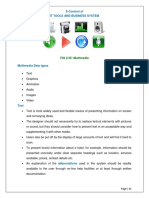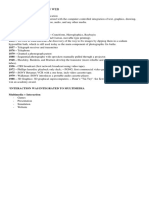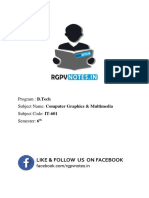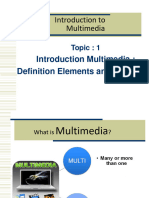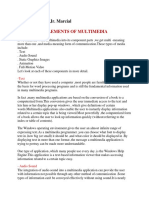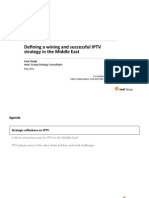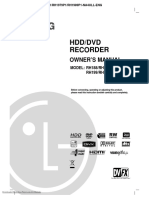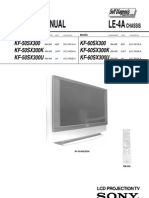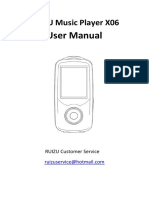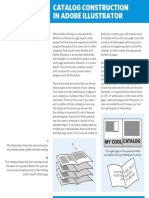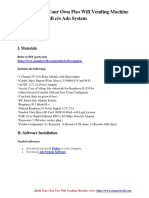NILE UNIVERSITY OF SCIENCE
& TECHNOLOGY
MULTIMEDIA APPLICATION
�Components of
Multimedia
By: Jamal Nasser
� (1)Text
• Text or written language is the most common way of
communicating information.
• It is one of the basic components of multimedia. It was
originally defined by printed media such as books and
newspapers that used various typefaces to display the
alphabet, numbers, and special characters.
• Although multimedia products include pictures, audio and
video, text may be the most common data type found in
multimedia applications. Besides this, text also provides
opportunities to extend the traditional power of text by linking
it to other media, thus making it an interactive medium.
� (i)Static Text
• In static text, the words are laid out to fit in well
with the graphical surroundings. The words are
built into the graphics just like the graphics and
explanation given in the pages of the book, the
information is well laid out and easy to read.
• The learners are able to look at the pictures and
read the textual information, as they are
available on the similar screen.
� (ii) Hypertext
• A hypertext system consists of nodes. It contains the text
and links between the nodes, which define the paths the
user can follow to access the text in non-sequential ways.
• The links represent associations of meaning and can be
thought of as cross-references. This structure is created by
the author of the system, although in more sophisticated
hypertext systems the user is able to define their own
paths.
• The hypertext provides the user with the flexibility and
choice to navigate through the material. Text should be
used to convey imperative information and should be
positioned at appropriate place in a multimedia product.
� Cont’
• Well-formatted sentences and paragraphs are
vital factors, spacing and punctuation also affects
the readability of the text. Fonts and styles
should be used to improve the communication of
the message more appropriately
� (2) Image
• Images are an important component of
multimedia. These are generated by the
computer in two ways, as bitmap or raster
images and as vector images
(I) Raster or Bitmap Images
Photorealistic
Large file
(ii) Vector Images
Non photorealistic
The more complex it is the larger the file
� Cont’
• A bitmap image requires the number of pixels to
produce appropriate height, width and colour
depth, the vector image is based on a relatively
limited number of drawing commands
• Compression techniques are used to reduce the
file size of images that is useful for storing large
number of images and speeding transmission for
networked application. Compression formats
used for this purpose are GIF, TIFF,PNG and JPEG.
� (3)Animation
• Animation consists of still images displayed so quickly that they give
the impression of continuous movement.
• The movement of that image along paths is calculated using
numerical transformations applied to their defining coordinates.
• To give the impression of smoothness the frame rate has to be at
least 16 frames per second, and for natural looking motion it should
be at least 25 frames per second.
• Animations may be two or three dimensional. In two dimensional
animation the visual changes that bring an image alive occur on the
flat X and Y axis of the screen, while in three dimensional animation
it occurs along the entire three axis X, Y and Z showing the image
from all the angles. Such animations are typically rendered frame
by high-end three dimensional animation softwares.
• Animation tools are very powerful and effective.
� Basic types of Animations
• There are two basic types of animations,
(i) Path Animation
Path animations involve moving an object on a
screen that has a constant background e.g. a
cartoon character may move across the screen
regardless any change in the background or the
character.
� (ii) Frame Animation
• Frame animations, several objects are allowed to move
simultaneously and the objects or the background can also
change.
• The moving objects are one of the most appropriate tools
to enhance understanding, as they allow the learner to see
the demonstration of changes, processes and procedures.
• Animation uses very little memory in comparison to digital
video as it consists of drawing and moving instructions.
• Animation is very useful for such multimedia applications
where moving visuals are required, but where digital video
may be unsuitable, unnecessary, or too expensive in terms
of disc space or memory.
� (4) Sound
• Sound is probably the most sensuous element of
multimedia. It is meaningful speech in any language,
from a whisper to a scream. It can provide the listening
pleasure of music, the startling accent of special effects,
or the ambience of a mood setting background.
• It can promote an artist, add interest to a text site by
humanizing the author, or to teach pronouncing words in
another language.
• Sound pressure level (volume) is measured in decibels,
which is actually the ratio between a chosen reference
point on a logarithmic scale and the level that is actually
experienced.
� (i) Musical Instrument Digital Identifier
(MIDI)
• Musical Instrument Digital Identifier (MIDI) is a
communication standard developed in the early 1980s for
electronic musical instruments and computers.
• It is the short hand representation of music stored in numeric
form.
• MIDI is the quickest, easiest and most flexible tool for
composing original score in a multimedia project. To make
MIDI scores sequencer, software and sound synthesizer is
needed. A MIDI keyboard is also useful for simplifying the
creation of musical scores. Its quality depends upon the
quality of musical instruments and the capabilities of sound
system.
• It is device dependent
� (ii) Digital Audio
• Digitised sound is sampled sound. The every nth
fraction of a second, a sample of sound is taken and
stored as digital information in bits and bytes.
• The quality of this digital recording depends upon
how often the samples are taken (sampling rate) and
how many numbers are used to represent the value
of each sample (bit depth, sample size, resolution).
• The more often the sample is taken and the more
data is stored about that sample, the finer the
resolution and quality of the captured sound when it
is played back
� (5)Video
• Video is defined as the display of recorded real
events on a television type screen. The embedding of
video in multimedia applications is a powerful way to
convey information. It can incorporate a personal
element, which other media lack. The personality of
the presenter can be displayed in a video.
• The video may be categorised in two types, analog
video and digital video.
i. Analog video
ii. Digital video
� (i) Analog Video
• Is the video data that is stored in any non-computer media like
videotape, laserdisc, film etc. It is further divided in two types,
composite and component analogue video.
• Composite Analog Video has all the video components
including brightness, colour, and synchronization, combined
into one signal. Due to the composition or combining of the
video components, the quality of the composite video is
resulted as colour bleeding, low clarity and high generational
loss.
• Generational loss means the loss of quality
� (ii) Digital Video
• It is the most engaging of multimedia venues, and it is a
powerful tool for bringing computer users closer to the
real world.
• Digital video is storage intensive.
• A high quality colour still image on a computer screen
requires one megabyte or more of storage memory.
• To provide the appearance of motion, picture should be
replaced by at least thirty times per second and the
storage memory required is at least thirty megabyte for
one second of video.
• The more times the picture is replaced, the better is the
quality of video.
� Cont’
• Video requires high bandwidth to deliver data in networked
environment.
• This overwhelming technological bottleneck is overcome
using digital video compression schemes.
• There are video compression standards as MPEG, JPEG,
Cinepak and Sorenson.
• In addition to compressing video data, streaming
technologies such as Adobe Flash, Microsoft Windows
Media, QuickTime and Real Player are being implemented
to provide reasonable quality low bandwidth video on the
web. QuickTime and Real Video are the most commonly
used for wide spread distribution
� Categories of Digital video
formats
• Divided into two categories:-
i)Composite video
Digital recording formats encode the information in binary
(0‟s and 1‟s) digital code.
It retains some of weakness of analogue composite video like
colour and image resolution and the generation loss when
copies are made.
� ii)Component video.
• Component digital is the uncompressed format
having very high image quality.
• It is highly expensive. Some popular formats in
this category are „Digital Bitacam‟ and D-5
developed in 1994 and DVCAM developed in
1996.
� END
THANK YOU
























